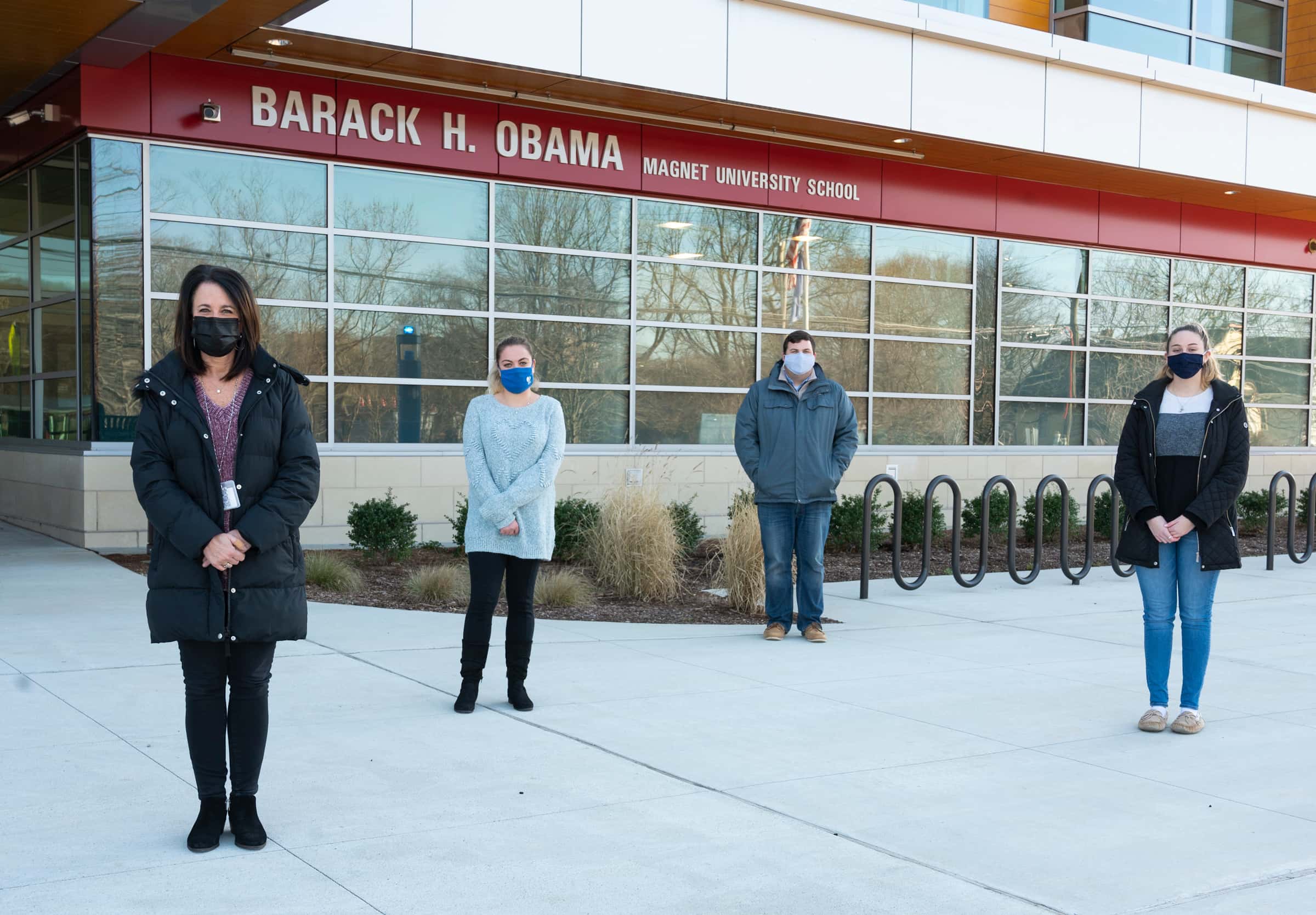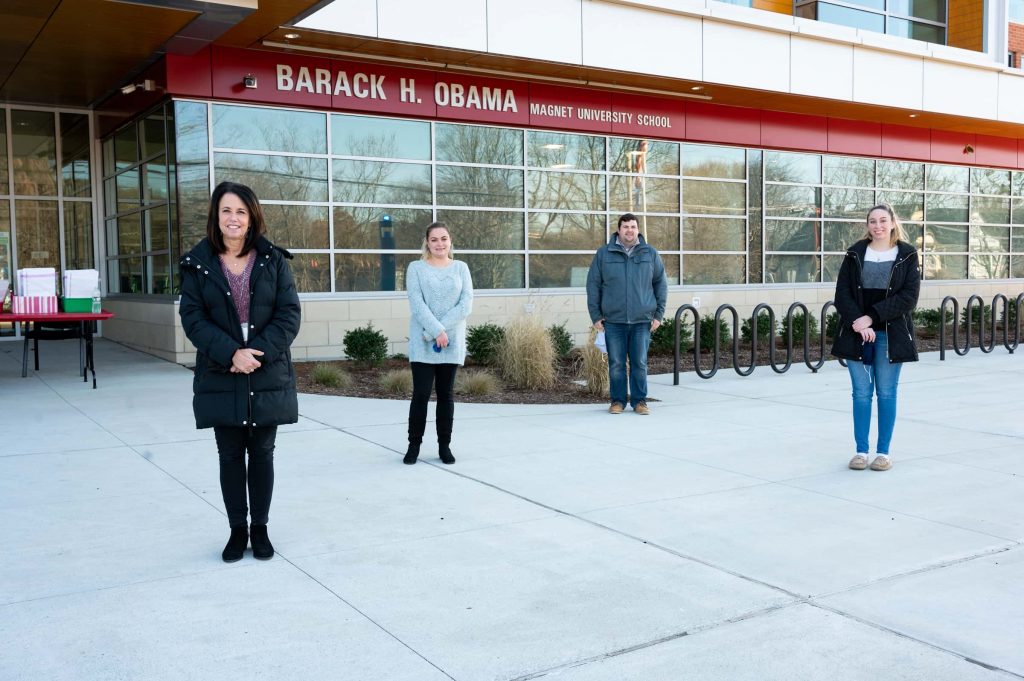We have come to view technology as a blessing, a miracle of our modern times. Its ubiquity is a testament to its astonishing popularity and scope of influence in our lives — it has become less a luxury than a necessity. Yet for all its benefits, when it comes to teaching grade schoolers, technology is a poor substitute for face-to-face interaction, collaborative learning, and, most of all, flesh-and-blood teachers.
When the Barack H. Obama Magnet University School opened on Southern’s campus on Jan. 7, 2020, it was impossible to imagine that it would shutter its building two months later. Citywide closures to prevent the spread of the COVID-19 virus sent administrators and teachers scrambling to pivot lessons online, and although the Obama School aims to integrate the latest educational innovations into its curriculum, no one could prepare it for an overnight transition from one mode of instruction to another.
“This has been a real learning curve for everybody,” says Principal Susan DeNicola, ‘86, M.S. ‘90, 6th Yr. ‘99. “Even for the people who were extremely tech savvy, this has definitely been a real shift in the way we were teaching prior to the pandemic.”
But teachers at the Obama School have more than adapted to the new setting; they have embraced it in an effort to advance the school’s mission to serve as a nationwide model in pedagogical practices. This includes an opportunity for Southern education majors to immerse themselves in experiential learning.
This year, however, student teachers Justin Pelazza, who will be graduating with an M.A. in teaching, and Haley M. Dattilo, an undergraduate in early childhood education, have had to fulfill their student teaching requirements “without ever setting foot into a classroom with students,” as Pelazza puts it.
While both Pelazza and Dattilo are permitted to teach live from empty classrooms, it was a different story back in March; teachers simply posted assignments online and expected students to complete them.
“We couldn’t get a handle on what was happening then, but once we became live in September we got a chance to see the kids’ faces,” says DeNicola.
Of course, live instruction brings with it a new crop of challenges. In the first weeks of school, students spent time familiarizing themselves with the features available on Google Suite and Google Classroom, their new homeroom, so to speak.
“It was a lot of teaching them how to do simple tasks, like copying and pasting or creating and resizing a text box,” says Pelazza, whose fourth-grade class had no trouble operating a computer.
Although logistics may burrow into class time, Pelazza admits that, generally speaking, lessons tend to move at a slower pace online. Not only must he toggle among four separate devices, he now spends twice as long getting through mini-lessons as he would in a traditional classroom setting. That is, a 10-minute lesson may now take up to half an hour.
That’s just the beginning. There’s also the inevitability of distractions now that students are grounded at home and the question of how to ensure their focus remains on the teacher. “It was very challenging to keep [students] interested in what we were doing because they had more unrestricted access to the Internet and got distracted by what was going on around them,” according to Dattilo, who student teaches kindergarten and third grade.
This potential for distraction is mainly why teachers like to use interactive online tools to keep students engaged throughout the day. Each morning students log into their Google Classroom accounts and check a digital notebook displaying their schedule for the day, complete with links to assignments and various activities. Sometimes these links direct them to sites such as Padlets, an online notice board; DreamBox, which incorporates math lessons into games; or Epic, an extensive digital library. “We use a variety of different programs to supplement the education in all areas of the curriculum,” says DeNicola.
Online learning resources also provide ways for teachers to give incentives to inattentive students. For instance, Peyton R. Northrop, ‘20, who student taught at the Obama School last spring and later subbed for fourth grade, says the most obvious sign her students were slacking was when they kept their cameras off. In turn, she decided to use a reward system to motivate them—if they handed in their work on time, then they would each earn ‘Dojo Points.’
“Kids would earn points toward a goal. Before the pandemic we would watch a movie or maybe have a pajama day. When we went virtual, we did little things, like play trivia games on Kahoot! at the end of the week,” says Northrop, who was recently hired as a pre-K teacher assistant at the school.
As one would expect, preschoolers and kindergarteners require a less rigorous approach to online learning. Their school day is broken up into smaller, more manageable chunks, and, unlike older students, they mainly rely on weekly packets and crafts sent to them by their teachers.
“Because we’re not there with them, they cut and paste, draw pictures, and now they’re learning to write sentences and sound them out,” says Dattilo. “They don’t know that in kindergarten you’re supposed to come into the class and sit on the carpet.”
The amount of time students spend sitting in front of a computer is based on grade level. Preschoolers and kindergarteners assemble for their morning meeting, go off to work asynchronously, and then return for their next lesson. They’re on and off all day. Older children break off for lunch and recess, but they’re on until their 2:45 p.m. dismissal. Always there is a teacher available during breaks to address questions and offer additional support.
Sadly, remote learning is not as easy as firing up Google Meet and switching on a webcam — with students’ home lives flashing through a screen, there is also the legal matter of privacy. “Once you become live in a classroom, you’re seeing into students’ homes, and they’re also seeing into yours,” says DeNicola. “We had to make sure that, legally, everything was being done correctly.”
Teachers completed a Mandated Reporter Training at the beginning of the school year to learn about ways to report suspicions of child abuse or neglect. “When we are virtual, it is a window into our lives, but it’s good to have that background knowledge on their home lives,” says Northrop.
It is amid challenges, however, that a sense of community grows. The relationship between parents, who have been crucial in their children’s education, and the Obama School has been greatly strengthened, says DeNicola. Teachers, as well as student teachers, have been handling the conversion to digital format gracefully, and, as DeNicola points out, the experience is preparing student teachers to thrive in any environment.
The ultimate blessing in disguise, though, may be that the pandemic struck at a time when our society enjoys a high level of technological sophistication. “We made sure that every student had a device, whether it was an iPad or a Chromebook. The district even provided hotspots and Wi-Fi,” says DeNicola.
Of course, students at the Obama School seem to be adapting equally well, if not better, to the changing times. Roughly ten percent of the student population is absent daily—a number that mirrors pre-pandemic attendance rates. “Growing up in such a tech-fluid world, I think our generation was better prepared for it and was able to readily incorporate more tech into their lives,” says Northrop.
The days of traditional education may not yet be behind, but innovation is certainly on the rise.



